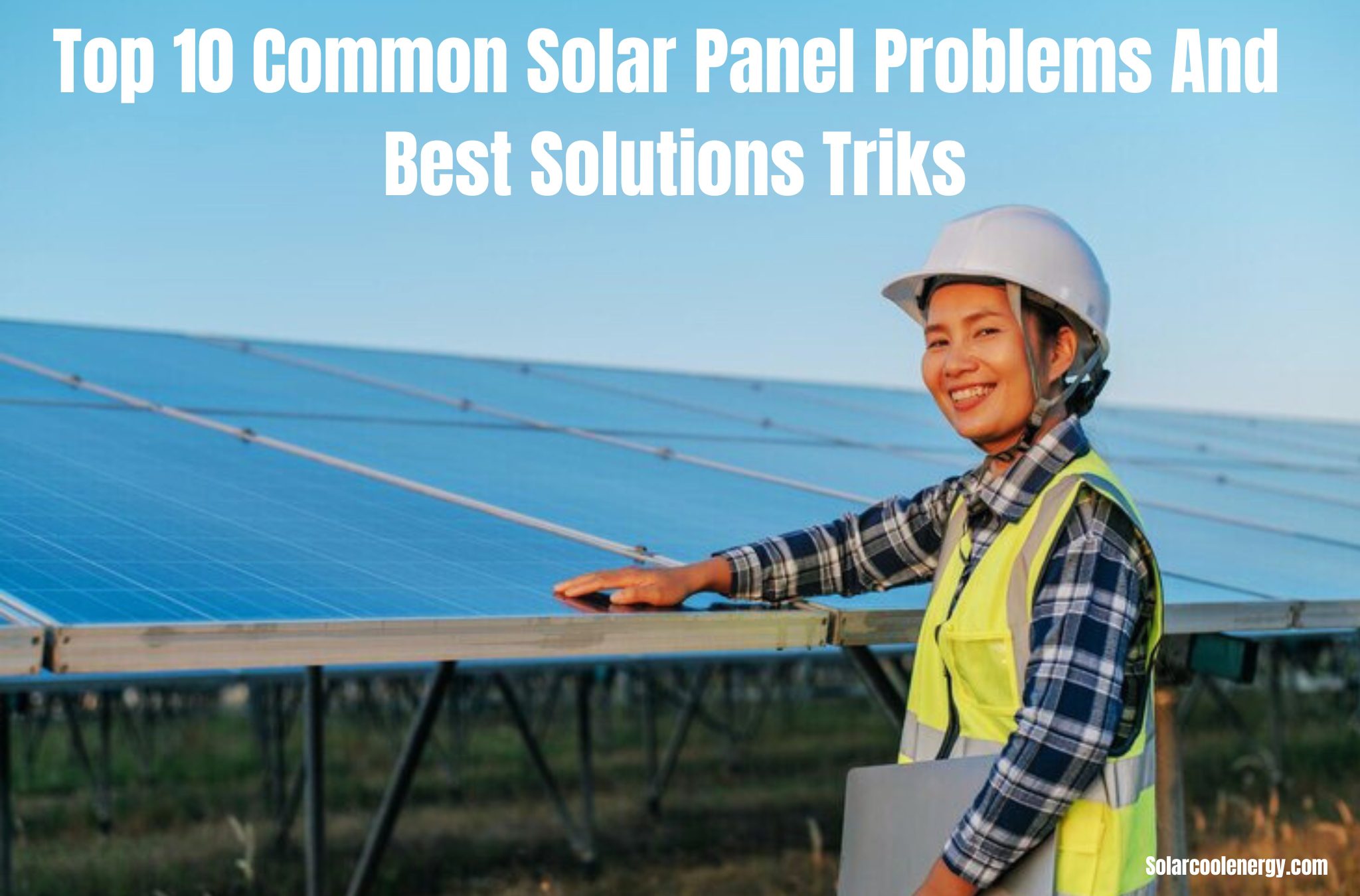Common solar panel problems include inverter problems, cracks, malfunctioning solar meter, snail trails, hot spots, PID effect, roof damage, wiring issues, and corrosion. These problems can lead to a decrease in the efficiency and performance of solar panels.
It is important to address these issues promptly to ensure optimal functioning and maximize the benefits of solar energy. Neglecting these problems can result in potential safety hazards and expensive repairs. Regular maintenance and professional inspections can help identify and resolve these common solar panel problems, ensuring long-term sustainability and effectiveness of solar power systems.

Understanding Solar Panel Issues
Solar energy has gained tremendous popularity in recent years as a clean and renewable source of power. However, like any technology, solar panels can experience issues that affect their efficiency and performance. In this section, we will explore common solar panel problems, their causes, and potential solutions to ensure your solar energy system continues to function optimally.
Importance Of Regular Maintenance And Troubleshooting
Regular maintenance and troubleshooting play a crucial role in maximizing the lifespan and performance of your solar panels. By being proactive in identifying and addressing potential issues, you can prevent costly repairs and ensure that your solar energy system operates at its peak efficiency. Here are some key reasons why regular maintenance and troubleshooting are essential:
- Identifying Potential Issues Early: Regular maintenance allows you to detect and address any potential issues before they escalate into major problems. By identifying issues early, you can minimize downtime and prevent further damage to your solar panels.
- Optimizing System Performance: Regular maintenance helps optimize the performance of your solar panels by keeping them clean and free from any obstructions. This ensures maximum sunlight absorption and energy generation, resulting in higher energy yields.
- Extending Lifespan: Proper maintenance and troubleshooting can extend the lifespan of your solar panels. By addressing issues promptly and maintaining the system’s components, you can ensure that your solar energy system continues to operate effectively for years to come.
- Protecting Your Investment: Solar energy systems are a significant investment, and regular maintenance helps protect that investment. By consistently monitoring and maintaining your solar panels, you can safeguard your system’s efficiency and avoid costly repairs or premature replacements.
Remember, Common Solar Panel Problems can range from minor issues to more severe complications, such as cracks, hot spots, or wiring problems. Therefore, it is essential to engage in regular maintenance and troubleshooting to catch any issues early and mitigate any potential risks to your solar energy system.
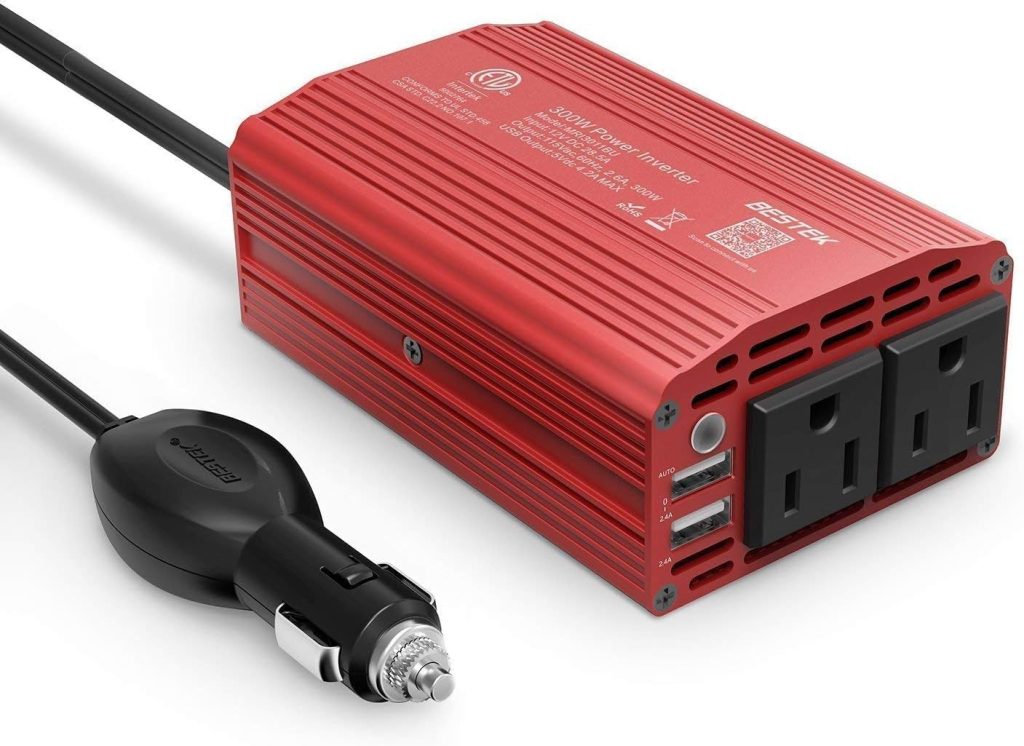
Identifying Inverter Problems
The inverter is a crucial component of a solar panel system, responsible for converting the direct current (DC) electricity produced by the solar panels into alternating current (AC) electricity for use in your home or business. However, Common Solar Panel Problems like any other electrical device, inverters can experience malfunctions or issues that can affect the efficiency and functionality of your solar system. In this section, we will discuss the role of inverters in solar panel systems, signs of inverter malfunction, and troubleshooting solutions to address these problems.
Overview Of The Role Of Inverters In Solar Panel Systems
The inverter plays a pivotal role in the conversion of solar energy into usable electricity. It is responsible for transforming the DC energy produced by the solar panels into AC energy that can power your household appliances. Without an inverter, the electricity generated by your solar panels would be unusable.
In addition to converting the electricity, inverters also monitor the performance of the solar panels, ensuring that they are operating efficiently and safely. They provide real-time data and monitoring capabilities, allowing you to identify any issues or inconsistencies in the system’s performance.
Signs Of Inverter Malfunction
Identifying potential inverter problems is crucial to ensure the smooth operation of your solar panel system. Here are some signs that may indicate inverter malfunction:
- Decreased or fluctuating energy production: A sudden drop in energy production or inconsistent output could be a sign of inverter malfunction. Monitor your system’s energy production regularly to identify any significant changes.
- Strange noises or smells: Unusual buzzing, humming, or clicking sounds, as well as strange odors, emanating from the inverter might indicate internal issues. Pay attention to any unusual noises or smells near your inverter.
- Lack of communication with monitoring devices: If your inverter fails to communicate with your monitoring devices or displays error messages, there may be a problem with the inverter’s internal circuitry or communication components.
Troubleshooting And Potential Solutions
If you suspect an inverter problem, there are a few troubleshooting steps you can take before contacting a professional:
- Check the inverter display: Take a look at the inverter display or monitoring software for any error messages or warning lights. Refer to the manufacturer’s manual or online resources to understand the meaning of these indicators and potential solutions.
- Inspect the wiring connections: Examine the wiring connections of the inverter to ensure they are secure and properly connected. Common Solar Panel Problems Loose or faulty wiring can lead to inefficiencies or even inverter failure.
- Restart the inverter: Sometimes, a simple restart can resolve minor issues with the inverter. Turn off the inverter, wait for a few minutes, and then turn it back on. This can help reset the internal components and potentially resolve the problem.
- Contact a professional: If the above troubleshooting steps do not resolve the issue, it is recommended to contact a professional solar panel technician or the manufacturer’s customer support for further assistance. They have the expertise to diagnose and repair more complex inverter problems.
Identifying inverter problems early and addressing them promptly can help ensure the optimal performance and longevity of your solar panel system. Regular maintenance and monitoring are key to identifying any potential issues and keeping your solar system running smoothly.
Causes Of Cracks In Solar Panels
There are several reasons why solar panels might develop cracks over time. These include:
- Thermal stress: Solar panels are exposed to extreme temperature changes which can cause the materials to expand and contract. Common Solar Panel Problems
- Hailstorms: Hail is a common cause of damage to solar panels, especially if the hailstones are large and strike the panels with force.
- Impact damage: Falling branches, debris, or even wildlife can cause physical impact to the panels, resulting in cracks.
- Manufacturing defects: In some cases, cracks can occur due to poor manufacturing processes or faulty materials.
How To Detect Cracks In Solar Panels
It’s important to regularly inspect your solar panels to check for any signs of cracks. Some ways to detect cracks include:
- Visual inspection: Take a close look at the surface of your solar panels for any visible cracks or fractures.
- Infrared imaging: Using an infrared camera, you can identify temperature variations on the panel’s surface, which may indicate the presence of cracks.
- Electroluminescence (EL) imaging: This technique involves capturing images using specialized equipment to detect cracks and other defects not visible to the naked eye.
Repair Options For Cracked Panels
If you discover cracks in your solar panels, it’s crucial to take immediate action to prevent further damage and ensure optimal efficiency. Here are some repair options:
- Sealing cracks: Depending on the severity of the cracks, a sealant can be applied to prevent moisture from entering and causing corrosion or electrical issues.
- Replacing damaged cells: In some cases, it may be necessary to replace the cracked cells to restore the panel’s functionality.
- Professional repair services: Hiring a professional Common Solar Panel Problems repair technician will ensure that the cracks are properly assessed and repaired using industry-standard techniques.
Remember, the sooner you address cracks in your solar panels, the better chance you have of preventing further damage and maximizing the lifespan of your solar energy system.
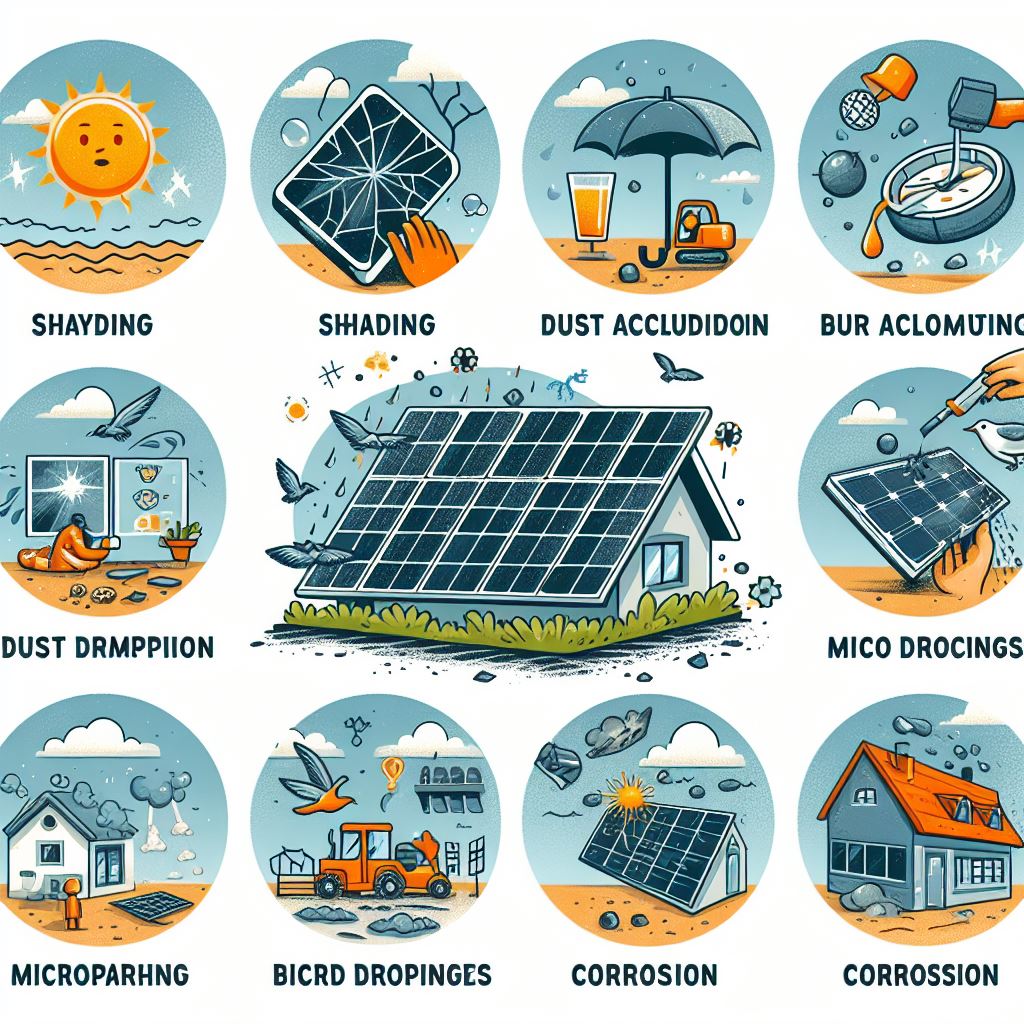
10 Common Solar Panel Problems Best Solutions Triks
Certainly! Here is a list of the top 10 common solar panel problems and their solutions, along with some useful tricks to help you maintain and troubleshoot your solar panel system effectively:
Dust and Dirt Accumulation
- Problem: Over time, dust, dirt, and debris can accumulate on solar panels, reducing their efficiency.
- Solution: Regularly clean your solar panels with a soft brush, mild detergent, and water. Avoid using abrasive materials or high-pressure water.
Shading Issues
- Problem: Shadows from trees, nearby buildings, or other obstructions can reduce the energy output of solar panels.
- Solution: Trim trees and bushes that cast shadows on your panels. Consider installing bypass diodes to minimize the impact of shading.
Inverter Failures
- Problem: Inverters can malfunction, leading to a drop in energy production.
- Solution: Monitor your inverter’s performance and schedule regular maintenance. Replace or repair the inverter when necessary.
Bird and Pest Nests
- Problem: Birds and pests may nest under or around solar panels, causing damage.
- Solution: Install bird or pest deterrents, such as mesh barriers or spikes, to keep them away.
Hot Spots
- Problem: Hot spots can occur when a single cell or section of a panel becomes overheated, potentially causing long-term damage.
- Solution: Ensure proper panel installation and monitoring. If hot spots are detected, consult a professional for repairs or replacements.
Electrical Issues
- Problem: Loose wires or faulty connections can disrupt the electrical flow within the solar panel system.
- Solution: Regularly inspect and tighten electrical connections. If you need clarification, consult an electrician or solar technician.
Hail Damage
- Problem: Hailstorms can damage solar panels, leading to reduced efficiency.
- Solution: Consider installing protective hail guards or insurance to cover potential damage.
Weather Damage
- Problem: Extreme weather conditions like heavy snow, storms, or hurricanes can harm solar panels.
- Solution: Secure your panels properly during severe weather. Check for physical damage afterwards and repair as needed.
Erosion of Panel Coating
- Problem: Weather, UV rays, and time can erode the protective coating on panels.
- Solution: Apply a UV-resistant coating or film to extend the life of your solar panels.
Lack of Maintenance
– Problem: Neglecting regular maintenance can lead to a decrease in panel efficiency.
– Solution: Create a maintenance schedule, including panel cleaning, inverter checks, and overall system inspections.
Trick: Install a solar panel monitoring system to keep track of your system’s performance in real time. This can help you identify and address issues promptly.
Regular maintenance, monitoring, and proactive problem-solving are key to ensuring the longevity and efficiency of your solar panel system. By addressing these common problems and following the solutions and tricks outlined above, you can maximize the benefits of your solar investment.
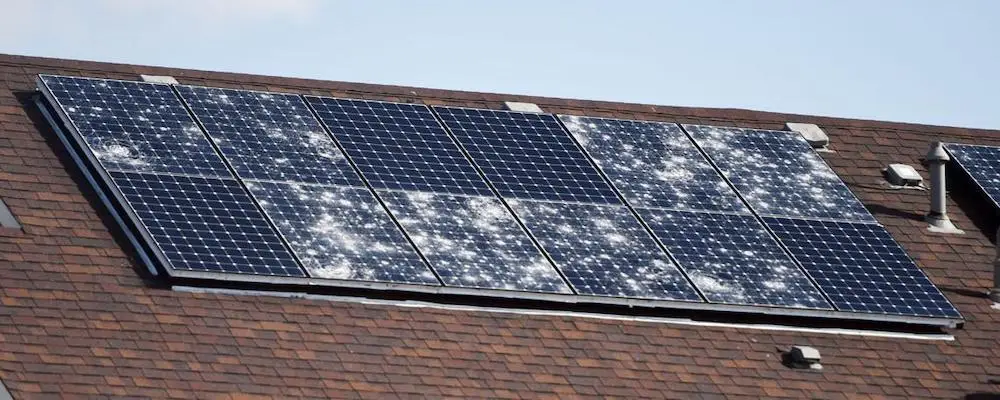
Credit: www.solarreviews.com
Dealing With Cracks In Solar Panels
Importance of accurate solar meter readings
Accurate solar meter readings are crucial for monitoring the performance of your solar panel system. The solar meter measures the amount of electricity generated by your panels and provides valuable data on their efficiency. It allows you to track the energy production, identify any issues, and ensure optimal performance. Without accurate readings, you may not be able to detect problems or understand the true benefits of your solar investment, leading to potential financial loss and energy wastage.
Common issues with solar meters
Despite their importance, solar meters can sometimes face various issues that affect their functionality. Some common problems include:
- Inaccurate readings: The meter may provide inaccurate measurements, either overestimating or underestimating the energy production.
- No readings: The meter may stop displaying any readings altogether, leaving you unaware of the energy generation.
- Fluctuating readings: The meter readings may fluctuate frequently without any apparent reason, making it difficult to determine the actual energy production.
- Connection issues: The meter may have poor connections or loose wiring, leading to disruptions in the data transmission.
Steps to troubleshoot and fix meter problems
If you encounter any issues with your solar meter, follow these steps to troubleshoot and fix them:
- Check meter connections: Ensure that all connections to the meter are secure and properly attached. Tighten any loose connections and ensure there are no damaged wires.
- Reset the meter: Try resetting the meter by turning it off and then turning it back on. This can sometimes resolve minor glitches or temporary disruptions in the meter’s functionality.
- Inspect the meter display: Examine the meter display for any error messages or abnormal readings. Note down any information that can help in diagnosing the issue.
- Contact your solar panel installer: If the problem persists or you are unsure about performing further troubleshooting steps, it is advisable to contact your solar panel installer or a qualified technician. They have the expertise to diagnose and fix complex meter issues.
Remember that troubleshooting a malfunctioning solar meter requires caution and technical knowledge. It is essential to follow proper safety protocols and seek professional assistance when needed to ensure accurate readings and optimal performance of your solar panel system. Common Solar Panel Problems
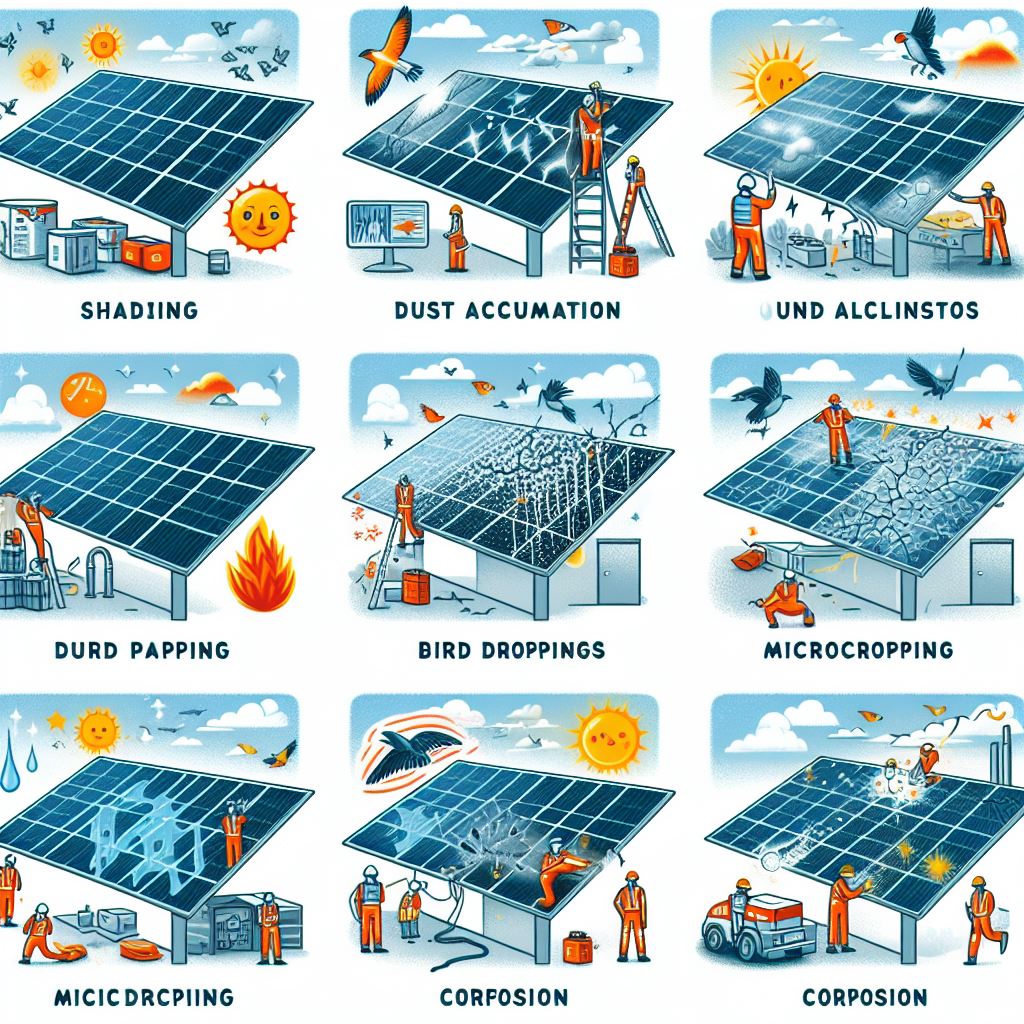
Addressing Potential Pid Effect
Potential Induced Degradation (PID) is a common issue that can affect the performance of solar panels over time. It occurs when leakage currents flow through the cells of the panel, leading to a decrease in power output and efficiency.
Understanding Potential Induced Degradation
PID is caused by a combination of factors, including high humidity, high voltage differentials, and certain panel designs. When these factors are present, negative charges accumulate on the surface of the solar cells, leading to an increase in leakage currents.
This buildup of negative charges is particularly common in areas with high levels of humidity, as moisture can seep into the panel and create conductive paths for the leakage currents. It is important to note that PID typically affects larger systems, such as commercial-scale installations, rather than smaller residential ones.
Symptoms And Long-term Effects Of Pid
Recognizing the symptoms and long-term effects of PID is crucial in addressing the issue. Some common symptoms include a decrease in power output, discoloration or darkening of the solar cells, and an increase in hot spots. Over time, these symptoms can lead to a significant loss of efficiency and a decrease in the overall lifespan of the solar panels.
Moreover, if left unchecked, PID can ultimately result in irreversible damage to the Common Solar Panel Problems system, requiring expensive repairs or even replacement.
Solutions To Mitigate Or Reverse Pid
Fortunately, there are several solutions available to mitigate or reverse PID and restore the performance of solar panels. These solutions include:
- Installing PID-resistant solar panels: PID-resistant panels are designed to minimize the negative effects of leakage currents and reduce the risk of PID. These panels often have specialized coatings or materials that prevent the accumulation of charges on the surface of the cells.
- Implementing a PID mitigation system: A PID mitigation system comprises various components, such as PID boxes or optimizers, that help control the voltage differentials and minimize leakage currents. These systems are typically installed alongside the Common Solar Panel Problems array.
- Regular cleaning and maintenance: Keeping the solar panels clean and free from dirt, dust, and debris is essential for maintaining their efficiency and reducing the risk of PID. Regular inspections and cleaning can help identify any potential issues and ensure optimal performance.
- Proper grounding and electrical connections: Ensuring proper grounding and electrical connections is crucial in preventing the buildup of leakage currents. Properly installed grounding systems help redirect the currents away from the solar cells and back into the earth.
By implementing these solutions, Common Solar Panel Problems owners can effectively address potential PID effect and ensure the long-term performance and durability of their systems.
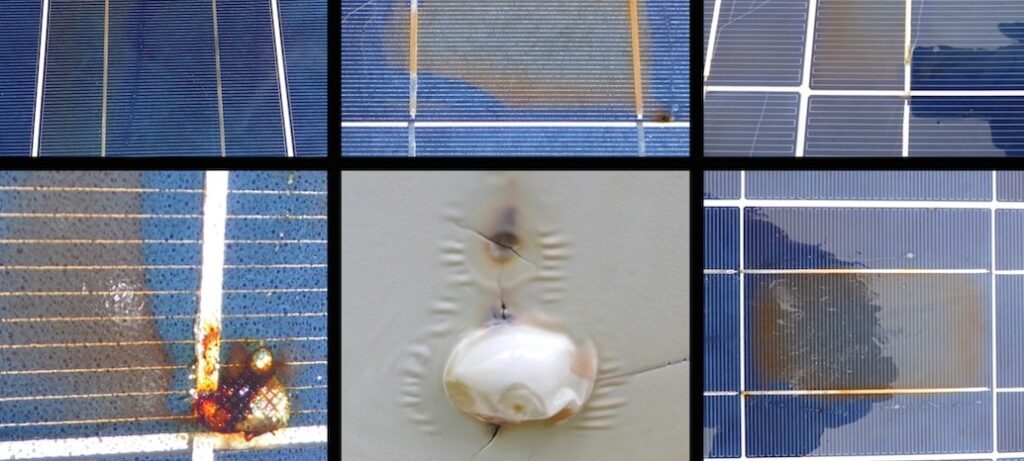
Credit: pv-magazine-usa.com
Dealing With Hot Spots In Solar Panels
Hot spots in Common Solar Panel Problems are a common problem that can significantly impact the performance and lifespan of the panels. In this article, we will discuss what hot spots are, their causes, how to detect and diagnose them, as well as preventive measures and solutions.
What Are Hot Spots And Their Causes
Hot spots in solar panels refer to localized areas that become excessively hot compared to the rest of the panel. These hot spots are typically caused by factors such as:
- Shade or obstructions on the panel surface, leading to uneven distribution of sunlight
- Poorly soldered joints or mismatches in solar cells, increasing resistance and generating excessive heat
- Cracks or damages in the solar cells, reducing their efficiency and creating areas prone to heating
Detecting And Diagnosing Hot Spots
To identify and diagnose hot spots in solar panels, it is crucial to regularly monitor the system and look out for the following signs:
- Visible burnt marks or discoloration on the panel surface
- Decreased power output or underperformance compared to the other panels
- Infrared imaging showing temperature variations across the panel
If any of these indicators are present, it is recommended to contact a professional technician or your Common Solar Panel Problems manufacturer for further assessment.
Preventive Measures And Solutions
Fortunately, there are preventive measures and solutions that can help mitigate hot spots in solar panels:
- Ensure proper installation by qualified technicians, minimizing the risk of shade or obstructions on the panel surface.
- Regularly inspect and maintain the Common Solar Panel Problems system, looking for any signs of cracks or damages.
- Implement proper temperature monitoring systems to detect abnormal heating.
- Consider using bypass diodes, which divert excess current away from damaged cells, reducing the risk of hot spots.
- Perform regular cleaning and maintenance to keep the panel surface free from debris or shading.
By following these preventive measures and promptly addressing any issues, you can ensure the efficiency, reliability, and longevity of your Common Solar Panel Problems system.
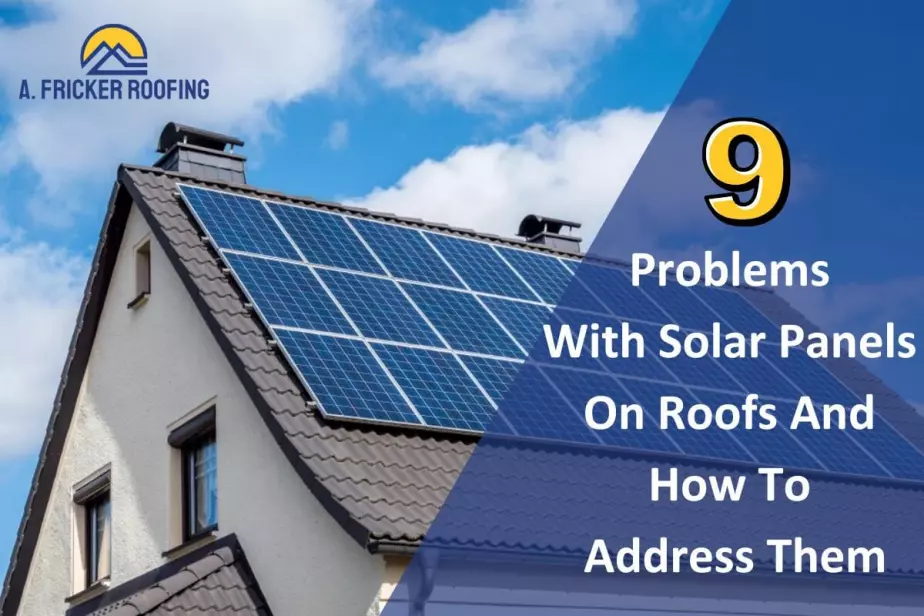
Credit: africkerroofing.com
Recognizing Roof Damage From Solar Panels
Impact Of Solar Panel Installation On Roofs
Installing solar panels on your roof can provide significant benefits, such as reducing your energy bills and decreasing your carbon footprint. However, it’s important to be aware of the potential impact this installation can have on your roof. The weight of the panels, as well as the installation process itself, can cause damage to your roof if not properly addressed.
Common Types Of Roof Damage
When it comes to roof damage caused by solar panel installation, there are several common issues that you should be aware of. These include:
- Leaks: Improper installation or sealing around the solar panels can lead to water leaks, which can cause damage to your roof and potentially result in costly repairs.
- Cracked or broken tiles: The weight of the solar panels can put strain on the tiles of your roof, causing them to crack or break. This not only compromises the integrity of your roof but also affects the aesthetic appeal of your home.
- Structural damage: If the installation of solar panels is not done correctly, it can lead to structural damage to your roof. This can include sagging or weakening of the roof structure, which can be a safety concern.
How To Identify And Address Roof Issues
If you have solar panels installed on your roof, it’s essential to regularly inspect for any signs of roof damage. Here are some steps you can take to identify and address roof issues:
1. Visual inspection:
Regularly examine your roof to look for any visible signs of damage, such as cracked tiles, loose or missing shingles, or areas where water may be pooling.
2. Water stains:
If you notice any water stains or discoloration on your ceiling or walls, this could indicate a leak in your roof. Promptly address the issue to prevent further damage.
3. Hire a professional:
If you’re unsure about the condition of your roof or suspect any damage, it’s best to hire a professional roofer to conduct a thorough inspection. They have the expertise to identify any potential problems and recommend the appropriate solutions.
4. Regular maintenance:
Maintaining your roof regularly is crucial to prevent and address any issues. This includes cleaning the gutters, removing debris from the roof, and trim ming back any overhanging tree branches that could potentially damage your roof.
5. Consult with your solar panel installer:
If you suspect roof damage or have any concerns about the impact of Common Solar Panel Problems installation on your roof, reach out to the company that installed your panels. They can provide guidance on how to address any issues and ensure the continued functionality and safety of your solar system.

Credit: m.economictimes.com
Troubleshooting Wiring Problems
Faulty wiring can be a common issue in Common Solar Panel Problems systems, affecting their overall performance. Understanding the importance of proper wiring and recognizing the signs of wiring problems is crucial for efficient solar panel operation. In this section, we will discuss the importance of proper wiring in solar panel systems, signs of wiring problems, and steps to diagnose and repair faulty wiring.
Importance Of Proper Wiring In Solar Panel Systems
Proper wiring is essential for the smooth functioning of Common Solar Panel Problems systems. It ensures the safe and efficient transfer of electricity from the panels to the electrical load or storage systems. Here are a few reasons why proper wiring is crucial for solar panels:
- Efficiency: Properly wired solar panels minimize energy loss, allowing for maximum power generation. This ensures optimal energy conversion and utilization.
- Safety: Correct wiring practices prevent electrical hazards such as short circuits, grounding issues, and electrical fires.
- Durability: Well-designed wiring reduces the risk of wear and tear, preventing issues like overheating, corrosion, and insulation damage.
Signs Of Wiring Problems
Identifying wiring problems at an early stage can help prevent further damage and ensure the longevity of your solar panel system. Here are some common signs of wiring problems:
- Unexpected system shutdowns: If your solar panel system frequently shuts down unexpectedly, it could indicate a wiring issue.
- Reduced energy production: Wiring problems can cause energy loss, resulting in lower overall power output from your solar panels.
- Visible physical damage: Check for any frayed or damaged wires, loose connections, or burnt insulation on the wiring components.
- Inconsistent voltage or current readings: Use a multimeter to measure the voltage and current at various points in the wiring system. Inconsistent readings may indicate a wiring problem.
Steps To Diagnose And Repair Faulty Wiring
Diagnosing and repairing faulty wiring requires careful troubleshooting and electrical expertise. Here are the steps to follow:
- Visual inspection: Start by visually inspecting the entire wiring system for any visible signs of damage, loose connections, or corrosion.
- Testing continuity: Use a multimeter to check for continuity along the wiring path, ensuring that there are no breaks or interruptions in the circuit.
- Checking connections: Verify that all connections, including terminals, junction boxes, and connectors, are secure and properly tightened.
- Replacing damaged components: If any wires, connectors, or other components are found to be faulty, replace them with new ones.
- Seek professional help: If you are unsure or uncomfortable with troubleshooting and repairing the wiring yourself, it is best to seek assistance from a qualified electrician or Common Solar Panel Problems technician.
By following these steps, you can effectively diagnose and repair faulty wiring in your solar panel system, ensuring optimal performance and longevity.
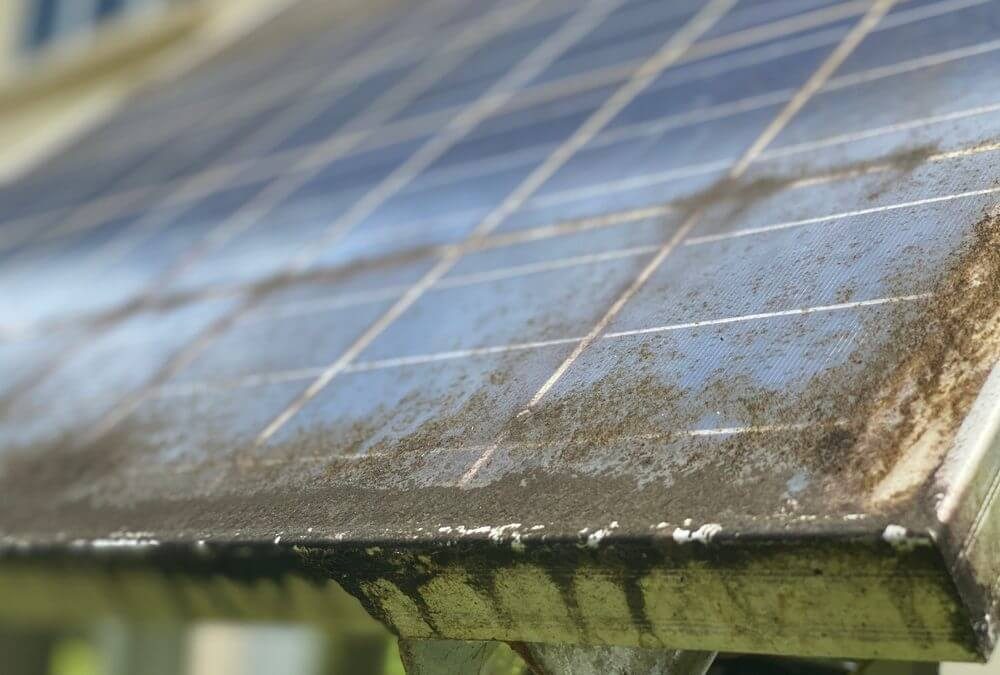
Credit: solarnrg.ph
Preventing And Treating Corrosion
Corrosion is one of the common problems faced by solar panel systems, and if left unchecked, it can significantly impact the efficiency and durability of the panels. In this section, we will explore the causes of corrosion in solar panel systems, indications of corrosion, and the preventative measures and treatment options available to effectively deal with this issue.
Causes Of Corrosion In Solar Panel Systems
Corrosion in solar panel systems can be attributed to various factors. Understanding the root causes of corrosion can help implement effective preventive measures. Some of the common causes include:
- Exposure to harsh environmental conditions, such as saltwater, humidity, or pollution
- Inadequate installation techniques or poor quality materials used
- Galvanic corrosion, which occurs when dissimilar metals come into contact
- Accumulation of moisture or condensation within the panel structure
- Chemical reactions between the panel components and external elements
Indications Of Corrosion
To diagnose and treat corrosion in Common Solar Panel Problems systems, it is crucial to be aware of the indications that might suggest the presence of corrosion. Some common signs of corrosion include:
- Visible rust or discoloration on the panel surfaces
- Presence of pitting or flaking on metal components
- Deterioration of panel performance or a decrease in energy output
- Unusual electrical fluctuations or disruptions within the system
- Corroded connectors or cables
Preventative Measures And Treatment Options For Corrosion
Preventing and treating corrosion is essential to maintain the longevity and efficiency of solar panel systems. Here are some effective preventive measures and treatment options:
- Regular inspection and maintenance: Performing routine inspections to identify any signs of corrosion and addressing them promptly can prevent further damage.
- Proper installation: Ensuring that the solar panels are installed correctly using high-quality materials can reduce the chances of corrosion.
- Using protective coatings: Applying specialized coatings or sealants on the panel surfaces can create a barrier against corrosive elements.
- Implementing corrosion-resistant materials: Choosing components and connectors made from corrosion-resistant materials can significantly reduce the risk of corrosion.
- Applying anti-corrosion treatments: Using corrosion inhibitors or anti-corrosion sprays on metal parts can mitigate the effects of corrosion.
Remember, regular maintenance and timely treatment will help maximize the lifespan of the solar panel system and ensure optimal performance.
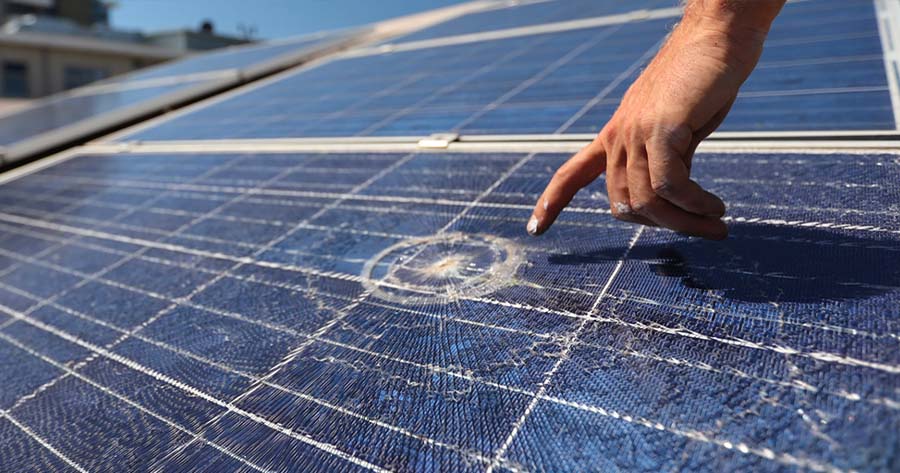
Credit: www.infiniteenergy.com.au
Frequently Asked Questions For Common Solar Panel Problems
What Are Common Failures In Solar Panels?
Common failures in solar panels include hot spots caused by manufacturing defects or high current flow, potential induced degradation (PID) caused by leakage currents, low cell conversion rate due to cracks, and delamination. Other issues can include inverter problems, snail trails, roof damage, and wiring corrosion.
Unexpected shutdowns may indicate manufacturing defects, faulty installation, or wiring problems. Imperfections in solar cells, such as cracks or poorly soldered joints, can lead to hotter spots, degradation, and potential fires. Delamination, internal corrosion, and inverter issues can also affect solar panels.
What Is The Biggest Issue With Solar Panels?
The biggest issue with solar panels are potential failures such as hot spots, low cell conversion rate, and delamination caused by imperfections in the cells. Cracks, poorly soldered joints, and mismatches can lead to higher resistance and become hot spots, which degrade the panels over time.
How Do I Know If My Solar Panels Are Faulty?
If your solar panels are faulty, you may experience unexpected shutdowns. Manufacturing defects, faulty installation, and wiring problems are common triggers for these shutdowns. Additionally, imperfections such as cracks or poorly soldered joints can lead to higher resistance and hot spots over time, which can degrade the panels and potentially cause fires.
What Goes Bad In A Solar Panel?
Solar panel problems can include inverter problems, cracks in the panels, malfunctioning solar meter, snail trails, hot spots, PID effect, roof damage, wiring issues, and corrosion. Imperfections in solar cells, such as cracks or poorly soldered joints, can lead to higher resistance and hot spots that can degrade the panels and potentially cause fires if not addressed.
Conclusion
While solar energy is a clean and sustainable source of power, it is not without its common problems. Issues such as inverter problems, cracks, malfunctioning solar meters, snail trails, hot spots, PID effect, roof damage, wiring issues, and corrosion can all affect the efficiency and performance of solar panels.
It is important for Common Solar Panel Problems owners to be aware of these problems and address them promptly to ensure the long-term reliability of their solar energy systems. Regular maintenance and professional inspections can help identify and resolve these issues, allowing for optimal energy production and savings.

